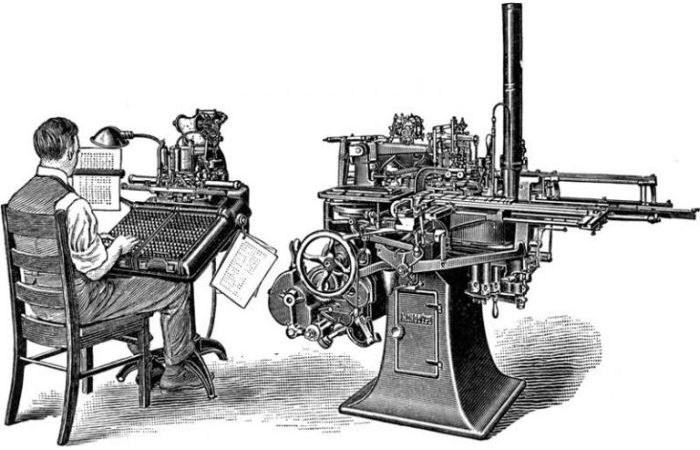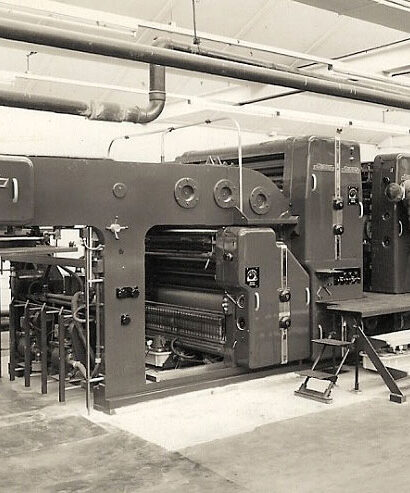During the 19th century press productivity experienced significant growth, driven by advancements in construction and the adoption of steam power. Consequently, print materials became more affordable and readily available to the working class. An emblematic illustration of this phenomenon is the emergence of penny prints, inexpensive single-page publications often commemorating noteworthy and unconventional occurrences.
In 1800, paper production in the United Kingdom amounted to 11,000 tons. By 1900, this figure soared to 652,000 tons, with a mere 4,000 tons attributed to handmade paper.

19th century penny print
The example above is a humorous 19th-century penny print depicting a henpecked husband who gets a beating from his bossy wife.
1800 – Iron presses
Inspired by the pioneering work of Swiss typefounder Wilhelm Haas, Charles Stanhope, the third Earl Stanhope, constructs a press featuring an iron frame rather than a wooden one, revolutionizing the printing process.

Stanhope press
It can print around 200 impressions per hour. Because this Stanhope press is also more durable and can print larger sheets, other press manufacturers soon switched to a similar type of construction.
1808 – First printing in Brazil
Printing presses were introduced relatively early in Spanish America, for instance in Mexico (before 1540) and Peru (1584). However, in Brazil, which was under Portuguese rule, this occurred much later. While some pamphlets were printed in the eighteenth century, the first official printing press was not installed until 1808.
1810 – History of Printing in America
Isaiah Thomas creates the two-volume History of Printing in America which is one of the best resources on colonial printing in the United States.
1814 – First cylinder presses
Friedrich Gottlob Koenig and Andreas Friedrich Bauer build their first cylinder press, which is much faster than the existing flatbed presses. One of the first customers is John Walter of the newspaper The Times. The first issue of The Times that is printed with the new presses is published in 1814. Koenig & Bauer cylinder press

K & B cylinder press
The machine is capable of printing over 1100 double-sided sheets per hour. In 1817 Koenig & Bauer return to Germany and start building presses in an abandoned monastery in Würzburg.
1817 – Cardboard boxes
The first cardboard box packaging is produced. The Kellogg Company is the first to use it for packaging cereals in the late 19th century.
1821 – De La Rue is founded
Thomas de la Rue starts a printing company in London. In 1831, the company can produce playing cards, with postage stamps following in 1855 and banknotes in 1860. Nowadays it is the largest security printing business in the world.
1822 – Church typesetting machine

Church typesetting machine (source: Wikimedia)
American inventor William Church patents the first typesetting machine. It features a keyboard linked to magazines that each contain a set of cast characters. The typesetter increases the number of letters that can be cast per day from between 3,000 and 7,000 to between 12,000 and 20,000.
1829 – Braille is invented
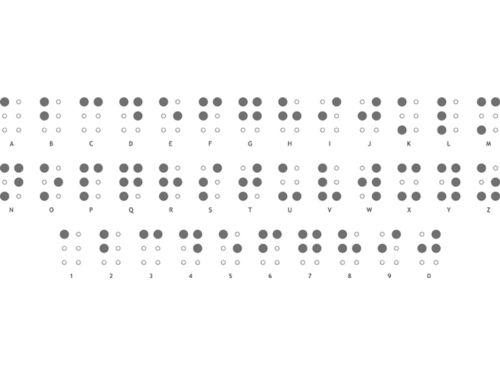
Braille alphabet
Louis Braille publishes his Braille alphabet, a tactile reading system for the blind.
1832 – Automating binding
Philip Watt invents the sewing machine, a major step forward in automating binding.
1835 – Bertelsmann
Carl Bertelsmann founds C. Bertelsmann Verlag as a German Protestant publishing house. Over time this company will become the largest printing group in Europe.
1837 – Chromolithography
In France, Godefroy Engelmann is awarded a patent on chromolithography, a method for printing in color using lithography. Chromolithographs or chromos are mainly used to reproduce paintings and scenic photographs.

Advertising made with color printing technique
The advertisement above is from the end of the century and shows what can be achieved using this color printing technique.

Hoen & Co.
In the United States, A. Hoen & Co in Baltimore is one of the first printing companies to use the technology.
1840 – The first adhesive postage stamp

Penny Black postage stamp
The Penny Black is the first adhesive postage stamp. It allows UK citizens to send letters of up to 14 grams to any location in the country at a flat rate of one penny.
1842 – The first illustrated weekly newspaper
The Illustrated London News is the world’s first illustrated weekly newspaper. It costs five pence. From 1861 onwards such newspapers becomes a lot cheaper in the United Kingdom because of the abolition of paper duty.
1843 – First use of photos in a book and first Christmas cards
Photographs of British Algae: Cyanotype Impressions by English botanist and photographer Anna Atkins is the first book ever to be illustrated exclusively with photographs.

Photographs of British Algae: Cyanotype Impressions
The 389 photos are all made by placing algae directly onto photographic paper and exposing them using sunlight.
In 1843 the American inventor Richard March Hoe builds the first lithographic rotary printing press, a press in which the type is placed on a revolving cylinder instead of a flatbed. This speeds up the printing process considerably and 22,000 to 24,000 impressions per hour can be achieved.

Rotary press
Printing gets even faster in 1870 when Hoe builds a rotary press that prints both sides of a page in a single operation. This roll-fed press has a speed of 240 meters (800 ft) per minute. It is used for printing newspapers and includes a built-in cutting unit and a separate folder.
1844 – Using wood to produce paper
The Canadian inventor Charles Fenerty and his German counterpart F.G. Keller simultaneously invent a new papermaking technique based on pulping wood. Until then all paper was made from pulped rags. Cotton fiber is still used today but only for specialty applications such as currency. As an alternative to wood, esparto grass can be used.
1848 – W. H. Smith & Son news stands
The English news vendor W. H. Smith & Son, established in 1792, opens its first news stand in a railway station. In the next two years the Euston booth is joined by stands in Birmingham, Manchester and Liverpool.
During the second half of the nineteenth century, the invention of the Linotype solves a major problem of the printing industry. Due to the ever-increasing speed of presses, typesetting had become a major bottleneck in the production process. The Linotype solved this problem for newspapers while book printers relied on hot metal typesetters from Monotype and others.
During this era many magazines that are still in existence today are brought to market, including ‘Scientific American’ (1845, originally a 4-page weekly), ‘Harper’s Magazine’ (1850), ‘National Geographic’ (1888) and ‘Vogue’ (1892).
1851 – The New-York Daily Times
The first issue is published of what will later become The New York Times.
1856 – Full-page ads
Robert E Bonner runs the first full-page ad in a newspaper. It promotes the New York Ledger, his own literary paper.
1858 – Gordon Jobber
Based on an earlier design by Stephen P. Ruggles, George Phineas Gordon produces the Franklin press, which is also known as the Gordon Jobber. The press uses a foot pedal to press the surface holding the paper against the flat inked printing plate.

Chandler and Price letterpress
Only a single operator is needed, making this a perfect press for small print shops. Until the early 1900s, these were the workhorses in many print shops, and some remain in use even today.
1864 – RR Donnelley is founded
R.R. Donnelley & Sons Company is founded in Lancaster, Pennsylvania. It becomes one of the largest custom map-making companies in the United States and gradually expands into other markets. Nowadays it is a Fortune 500 company that is still heavily print-oriented, next to offering global marketing and business communication services.
1865 – Faster web presses

William Bullock press
William Bullock perfects Hoe’s rotary press. His press doesn’t print on sheets but is fed by a roll of paper that is printed on both sides. The press then folds the paper and cuts sheets at a speed of up to 12,000 sheets an hour. Bullock dies during an operation to amputate his leg that accidentally got crushed in one of his presses.
1867 – Agfa is founded
Agfa, the Aktiengesellschaft fur Anilinfabrikation, is founded in Rummelsburg, Germany. Originally the company focusses on producing color dyes but it will gradually become one of the leading manufacturers of film, printing plates, and large-format printers.
1874 – Production of corrugated board
Mass production of corrugated board starts. It is initially used to package bottles and glass lantern chimneys.

Prang’s aids for object teaching – Source: American Antiquarian
The image above dates from that same year. It shows lithographic printing and is printed by Prang and Mayer from Boston who specialized in architectural and educational prints and greeting cards.
1876 – Duplicating documents with the Mimeograph

Edison’s Mimeograph
Thomas Edison receives a patent for a printing mechanism that around 1890 will result in the mimeograph or stencil duplicator. The Mimeo name is a trademark of Albert Blake Dick who licenses Edison’s patents.

KBA web-fed rotary press
Wilhelm Koenig designs the first KBA web-fed rotary press. It is installed at the Magdeburgische Zeitung. By 1895 the company delivers its 5000th cylinder press.
1884 – Mechanical sewing machines

Mechanical sewing machine
Hugo Brehmer develops the first mechanical thread-based sewing machine for bookbinding. The image below shows a sewing machine from a few years later.
1885 – Automating punch cutting
Linn Boyd Benton invents the pantographic punch cutter. With this machine, an operator can trace the brass pattern of a letter with one arm of the device. The punch-cutting machine makes the mass-production of punches possible and it paves the way for the Linotype and other composing machines.
1886 – Invention of the Linotype
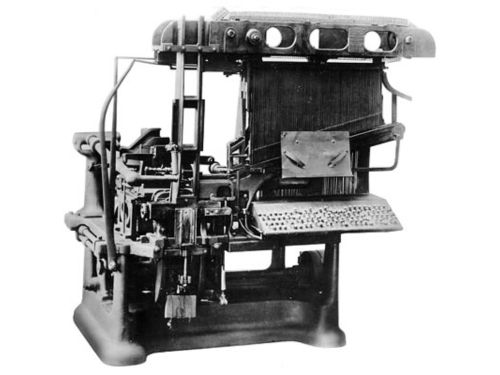
Linotype composing machine
Ottmar Mergenthaler invents the Linotype composing machine. With this typesetter, an operator can enter text using a 90-character keyboard. The name ‘line-o’-type’ is a pretty good description of what the machine does. It is widely regarded as one of the greatest advances in printing since the development of movable type 400 years earlier.
Around that same time the Swiss company Orell Gessner Füssli patents the ‘Aac process’ that is used to create photochroms, also called photochrome prints.

Photochrome depicting the Groenerei in Bruges, Belgium
The photochrom technique is very popular in the 1890s and mainly used for printing postcards of city scapes.

Lothar Meggendorfer’s International Circus
Lothar Meggendorfer’s International Circus is a pop-up book that contains six pop-up scenes of circus acts, including acrobats, clowns, and daredevil riders. Unfolded they form a circus complete with orchestra and spectators. It is not the first pop-up book to be published but thanks to reproductions, such as the 1979 version shown below, it is still available today.
1890 – First flexo press
Bibby, Baron, and Sons build the first flexographic press. This type of press uses the relief on a rubber printing plate to hold the image that needs to be printed. Because the ink that is used in that first flexo press smears easily, the device becomes known as Bibby’s Folly. Later improvements in technology do make flexography one of the most used industrial printing processes.
That same year Robert Gair accidentally invented the pre-cut cardboard box.
Around this time the Miehle Printing Press & Manufacturing Co. is founded by Robert Miehle. The company builds flat-bed cylinder presses and from 1921 onward will also produce a series of popular vertical cylinder presses.
1892 – Eastman Kodak Company is founded
George Eastman changes the name of his company to Eastman Kodak Company, which later becomes Kodak.
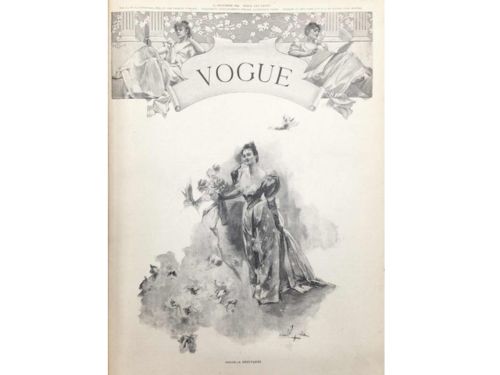
First issue of Vogue
That same year the first issue of Vogue, the American fashion and lifestyle magazine, is published. It begins as a weekly newspaper but in later years becomes a monthly publication.
1893 – Sears, Roebuck and Co. catalog
That same year the first Sears, Roebuck and Co. catalog was published. The image below is from the 1895 edition when bicycles were added.

Sears, Roebuck and Co. catalog
The first color section appears in 1897, to show off shoes in black, brown, and red. The first specialty catalog for automobiles dates back to 1913 and the first Christmas catalog follows in 1933. The ‘Big Book’ catalog is discontinued in 1993 when the Specialty Catalog Group is formed.

Novel series ‘Railway Library’
Also popular during the second half of the nineteenth century is the Railway Library. The novels in this series use a cheap straw pulp cover, allowing publisher George Routledge to make the books very affordable.
1895 – D. Stempel AG foundry
D. Stempel factory in 1913
David Stempel found the D. Stempel AG typographic foundry in Frankfurt am Main, Germany. It will employ important font designers like Rudolf Wolf and Hermann Zapf and is among the select foundries that produce matrices for the Linotype machine.
1896 – Lanston Monotype machine company
The Lanston Monotype Machine Company, founded by Tolbert Lanston in Washington D.C. in 1887, builds its first hot metal typesetting machine.

Monotype
In contrast to the Linotype which casts complete lines of type, the Monotype machine forms individual letters. That makes it easier to correct spelling mistakes by adding or removing an individual letter. This is an advantage for less time-critical work, such as typesetting books. In 1896 Monotype issues its first typeface, Modern Condensed.
1898 – First car ad

Advertisement for Winton Motor Carriage
The July issue of Scientific American includes an advertisement for the Winton Motor Carriage. This is generally considered to be the first ad for an automobile.
Machine Dalal is a global platform for buyers and sellers to connect and trade their equipment with ease. Contact us to learn more.
